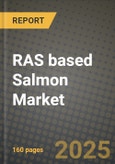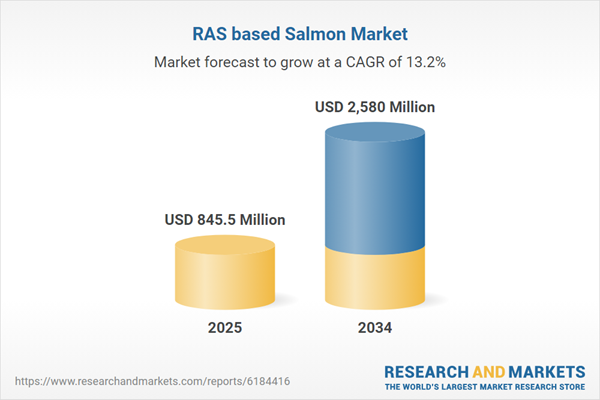RAS based Salmon Market
The RAS-based Salmon market is evolving from pilot and near-shore installations to scaled, fully land-based grow-out located close to consumption hubs. Recirculating Aquaculture Systems enable controlled environments with stable temperature, salinity, oxygen, and biosecurity, reducing exposure to sea-lice, harmful algal blooms, and climate variability. Top end-uses span smolt/post-smolt and full grow-out for Atlantic salmon, with adjacent uses in broodstock, genetics, and year-round supply of premium fillets. Key trends include proximity-to-market branding, antibiotic-free production, renewable-power integration, sludge-to-biogas valorization, and digitalization (sensor networks, vision systems, model-based control). Drivers center on licensing constraints in traditional sea-cage regions, rising ESG scrutiny, food security, and supply-chain resilience. Technology competition focuses on biofilter design (MBBR/IFAS), denitrification strategies, CO₂ stripping/degassing efficiency, oxygen management, off-flavor (geosmin) mitigation, and fail-safe redundancy. The competitive landscape blends vertically integrated producers, RAS technology vendors, EPC partners, and component suppliers (pumps, blowers, UV/ozone, sensors, controls, backup power). Success factors are biology-first operations, robust commissioning, energy optimization, and retail contracts that monetize consistent size, quality, and freshness. Overall, the market is shifting from capacity announcements to execution discipline - delivering survivability, feed conversion, and yield at predictable costs.RAS based Salmon Market Key Insights
- From concept to execution discipline
- Biosecurity and welfare as core value propositions
- Energy intensity and decarbonization pathways
- Water treatment and off-flavor management
- Controls, automation, and digital twins
- Feed, genetics, and health integration
- Redundancy and risk engineering
- Sludge handling and circularity
- Proximity-to-market economics and branding
- Capital discipline and staged build-outs
RAS based Salmon Market Reginal Analysis
North America
RAS salmon gains momentum near coastal metros and logistics hubs, leveraging renewable power access, abundant cold-chain, and retailer partnerships. Permitting emphasizes water discharge, zoning, and community engagement, favoring sites with existing industrial utilities. Operators stress energy optimization, redundant power, and biosecurity to satisfy insurers and lenders. Branding around freshness, welfare, and local jobs resonates with premium retail channels. A robust vendor base supports fast service and spare parts.Europe
Experience from smolt/post-smolt RAS translates into full grow-out projects, with strong regulatory scrutiny on effluents, welfare, and carbon footprints. Access to low-carbon power and district-energy linkages can materially improve operating economics. Projects benefit from engineering depth, proven component suppliers, and certification frameworks that validate welfare and environmental claims. Competition with sea-cage incumbents centers on consistent quality and year-round supply rather than volume alone.Asia-Pacific
Growing demand in Northeast and Southeast Asia favors near-market RAS to assure freshness and traceability. Sites focus on grid stability, water availability, and skilled labor for continuous operations. Technology partnerships transfer know-how on biofilter scaling, depuration, and high-density management. Retailers seek antibiotic-free assurances and predictable sizing for sashimi and premium foodservice. Local component manufacturing reduces capex and maintenance lead times.Middle East & Africa
Water scarcity and high temperatures make closed-loop systems attractive where desalinated or recycled water is available. Co-location with industrial parks enables stable power and heat integration. Projects emphasize robust cooling, degassing, and energy recovery to manage operating conditions. Government diversification agendas and food-security programs can support early adoption, while operator training and vendor presence are critical to reliability.South & Central America
Interest centers on diversifying beyond sea-cage production and accessing premium export markets with welfare and sustainability claims. Sites evaluate renewable power options and water rights to stabilize OPEX. Partnerships with experienced EPCs and component suppliers reduce execution risk, while phased modules allow learning before scale-up. Retail opportunities exist for local premium brands and export contracts that value year-round consistency and short supply chains.RAS based Salmon Market Segmentation
By Type
- Atlantic Salmon
- Others
By Application
- Food Service Sector
- Retail Sector
Key Market players
Atlantic Sapphire, Nordic Aquafarms, Pure Salmon, AquaBounty, Superior Fresh, Whole Oceans, Sustainable Blue, Danish Salmon, Swiss Lachs (Alpine Salmon), Proximar Seafood, Nordic Aqua Partners, West Coast Salmon, AquaCon, LocalCoho, KuterraRAS based Salmon Market Analytics
The report employs rigorous tools, including Porter’s Five Forces, value chain mapping, and scenario-based modelling, to assess supply-demand dynamics. Cross-sector influences from parent, derived, and substitute markets are evaluated to identify risks and opportunities. Trade and pricing analytics provide an up-to-date view of international flows, including leading exporters, importers, and regional price trends.Macroeconomic indicators, policy frameworks such as carbon pricing and energy security strategies, and evolving consumer behaviour are considered in forecasting scenarios. Recent deal flows, partnerships, and technology innovations are incorporated to assess their impact on future market performance.
RAS based Salmon Market Competitive Intelligence
The competitive landscape is mapped through proprietary frameworks, profiling leading companies with details on business models, product portfolios, financial performance, and strategic initiatives. Key developments such as mergers & acquisitions, technology collaborations, investment inflows, and regional expansions are analyzed for their competitive impact. The report also identifies emerging players and innovative startups contributing to market disruption.Regional insights highlight the most promising investment destinations, regulatory landscapes, and evolving partnerships across energy and industrial corridors.
Countries Covered
- North America - RAS based Salmon market data and outlook to 2034
- United States
- Canada
- Mexico
- Europe - RAS based Salmon market data and outlook to 2034
- Germany
- United Kingdom
- France
- Italy
- Spain
- BeNeLux
- Russia
- Sweden
- Asia-Pacific - RAS based Salmon market data and outlook to 2034
- China
- Japan
- India
- South Korea
- Australia
- Indonesia
- Malaysia
- Vietnam
- Middle East and Africa - RAS based Salmon market data and outlook to 2034
- Saudi Arabia
- South Africa
- Iran
- UAE
- Egypt
- South and Central America - RAS based Salmon market data and outlook to 2034
- Brazil
- Argentina
- Chile
- Peru
Research Methodology
This study combines primary inputs from industry experts across the RAS based Salmon value chain with secondary data from associations, government publications, trade databases, and company disclosures. Proprietary modeling techniques, including data triangulation, statistical correlation, and scenario planning, are applied to deliver reliable market sizing and forecasting.Key Questions Addressed
- What is the current and forecast market size of the RAS based Salmon industry at global, regional, and country levels?
- Which types, applications, and technologies present the highest growth potential?
- How are supply chains adapting to geopolitical and economic shocks?
- What role do policy frameworks, trade flows, and sustainability targets play in shaping demand?
- Who are the leading players, and how are their strategies evolving in the face of global uncertainty?
- Which regional “hotspots” and customer segments will outpace the market, and what go-to-market and partnership models best support entry and expansion?
- Where are the most investable opportunities - across technology roadmaps, sustainability-linked innovation, and M&A - and what is the best segment to invest over the next 3-5 years?
Your Key Takeaways from the RAS based Salmon Market Report
- Global RAS based Salmon market size and growth projections (CAGR), 2024-2034
- Impact of Russia-Ukraine, Israel-Palestine, and Hamas conflicts on RAS based Salmon trade, costs, and supply chains
- RAS based Salmon market size, share, and outlook across 5 regions and 27 countries, 2023-2034
- RAS based Salmon market size, CAGR, and market share of key products, applications, and end-user verticals, 2023-2034
- Short- and long-term RAS based Salmon market trends, drivers, restraints, and opportunities
- Porter’s Five Forces analysis, technological developments, and RAS based Salmon supply chain analysis
- RAS based Salmon trade analysis, RAS based Salmon market price analysis, and RAS based Salmon supply/demand dynamics
- Profiles of 5 leading companies - overview, key strategies, financials, and products
- Latest RAS based Salmon market news and developments
Additional Support
With the purchase of this report, you will receive:- An updated PDF report and an MS Excel data workbook containing all market tables and figures for easy analysis.
- 7-day post-sale analyst support for clarifications and in-scope supplementary data, ensuring the deliverable aligns precisely with your requirements.
- Complimentary report update to incorporate the latest available data and the impact of recent market developments.
This product will be delivered within 1-3 business days.
Table of Contents
Companies Mentioned
- Atlantic Sapphire
- Nordic Aquafarms
- Pure Salmon
- AquaBounty
- Superior Fresh
- Whole Oceans
- Sustainable Blue
- Danish Salmon
- Swiss Lachs (Alpine Salmon)
- Proximar Seafood
- Nordic Aqua Partners
- West Coast Salmon
- AquaCon
- LocalCoho
- Kuterra
Table Information
| Report Attribute | Details |
|---|---|
| No. of Pages | 160 |
| Published | November 2025 |
| Forecast Period | 2025 - 2034 |
| Estimated Market Value ( USD | $ 845.5 Million |
| Forecasted Market Value ( USD | $ 2580 Million |
| Compound Annual Growth Rate | 13.2% |
| Regions Covered | Global |
| No. of Companies Mentioned | 15 |









